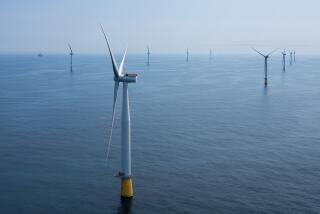Wind farms’ grim harvest
Each spring, sage grouse gather on their “lekking” grounds to engage in a cacophonous courtship ritual. Males inflate large orange air sacs on their chests and boom out eerie calls to attendant females, sounding like a bizarre orchestra of distant foghorns. The song was once familiar across the Great Basin, but in recent decades, cattle grazing, oil and gas exploration and the spread of invasive species have put a huge dent in sage grouse habitat.
Now wind power development is adding another threat. The birds will not breed near tall structures for fear of predators, and so the springtime booming of sage grouse is being replaced with the even eerier whoosh of whirring turbines.
It’s clear that global warming threatens ecosystems and that we need to take action to reduce carbon emissions if we hope to maintain the planet’s biodiversity. But one potential solution carries threats of its own that need to be mitigated.
Wind power is the fastest-growing form of alternative energy, with projections that it will grow twelvefold over the next 20 years. This will mean about 175,000 new turbines installed on more than 30,000 square miles of land -- more land than in New Hampshire, New Jersey, Connecticut, Delaware and Rhode Island combined.
Wind is currently the only energy sector in the United States that is free from most forms of federal regulation. From California to Appalachia, each month sees new wind installations springing up like daisies, often with far too little environmental review.
Although wind development is far less destructive than many types of energy production, such as mountaintop-removal coal mining, wind power’s threats to wildlife are not inconsequential. Regions with sustained high winds frequently overlap prime bird habitat, including the sagebrush and grasslands that sustain declining populations of sage grouse and prairie chickens.
In addition to habitat issues, bird collisions with wind turbines are mounting. It may look like those blades are spinning lazily in the breeze, but their tips can reach speeds of 200 miles per hour (for a 198-foot blade spinning at 15 revolutions a minute). The inevitable result is that birds and bats strike the blades, with estimates of as many as 11 birds killed by each turbine a year. Eagles, hawks and falcons are particularly susceptible as they hunt along ridge tops or in open areas. California’s own Altamont Pass wind project has illustrated the potential of the bird-kill problem.
Environmentalists and the wind industry have been discussing for several years how to adequately protect birds, bats and wildlife habitat while allowing development to continue. Not surprisingly, there have been conflicts along the way.
One stumbling block has been a proposal to place the breeding areas of sage grouse and prairie chickens (neither of which currently receives protection under federal endangered or migratory species statutes) off-limits. The wind industry has asserted that wind projects should be allowed anywhere in the country where there is good wind power potential, except for specifically protected areas. Conservationists argue that the fragmentation of remaining prairie and sagebrush habitat caused by wind development could be the final straw for sage grouse and other sensitive species.
Now, though, as a result of pressure from conservation groups, representatives from the wind industry sitting on the U.S. Fish and Wildlife Service’s Wind Advisory Committee have agreed to recommend large “no go” buffer zones around sage grouse and prairie chicken breeding grounds. Wind developers also have agreed to consult early with the Fish and Wildlife Service on new wind farm proposals.
The difficult issue of how to protect flocks of migrating birds from collisions with the turbine rotors has not yet been addressed by this committee, but the American Bird Conservancy and the Cornell Lab of Ornithology have organized a team of experts to develop recommendations and a research agenda to tackle these problems and knowledge gaps.
The upshot of deliberations involving industry, the federal government and conservation groups will bear fruit in the form of a set of recommendations produced by the Fish and Wildlife Service, scheduled to be released next year. The industry wants these to be voluntary guidelines, with incentives for industry compliance in addition to existing subsidies. Our group believes they should be mandatory. Only with the force of law will they have the strength to make sure wind power is truly green energy.
More to Read
Sign up for Essential California
The most important California stories and recommendations in your inbox every morning.
You may occasionally receive promotional content from the Los Angeles Times.









